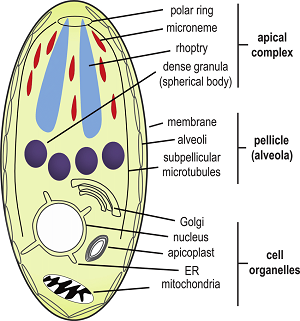Babesia - Introduction, History, Habitat, Morphology, Culture
Introduction of Babesia
Babesia is an intra-erythrocytic protozoan that causes opportunistic infections in humans. They are the causative agents of tick-borne and mainly cause malaria-like illnesses in domestic and wild animals.
In their life cycle, merogony takes place in the vertebrates while sporogony takes place in the invertebrates. Merozoite forms are present while oocysts, sporocysts, and pseudocysts are absent.
More than 70 species of Babesia have been recognized as parasites of bird and animal species. While in humans, three species are known to cause infection- B. bovis (cattle strain), B. divergens (cattle strain), and B. microti (rodent strain).
Classification of Babesia
The Classification of Babesia is as follows:
Kingdom: Chromista
Subkingdom: Harosa
Infrakingdom: Halvaria
Superphylum: Alveolata
Phylum: Apicomplexa
Class: Aconoidasida
Order: Piroplasmida
Family: Babesiidae
Genus: Babesia
History of Babesia
The history of Babesia began when Victor Babes was the first person to identify the protozoa parasite in a Romanian cattle RBC in 1888 and Babesiosis is named after him. In 1893, Smith and Kilbourne first demonstrated that Babesia spp is transmitted via ticks and is the cause of Texas cattle fever.
In 1957, Skrabalo reported the first case of babesiosis in a Yugoslavian cattle farmer. More than a decade later, in 1969, Babesia microti was found infecting a patient with an intact spleen.
Habitat of Babesia
Babesia spp habitats inside the erythrocytes/RBC as an intra-erythrocytic pathogen.
Morphology of Babesia
The important morphological forms of Babesia include:
Diagnostic forms in human
In humans, merozoites and trophozoites are found to infect the RBCs of humans or other mammal hosts.
Merozoites
Babesia merozoites are oval, round, or may present as pyriform bodies
arranged in pairs or multiples of two
Trophozoites
Babesia trophozoites are found inside erythrocytes
pleomorphic- may be oval, spherical and spindle-shaped
size varies from 1 μm to 5 μm
B. bovis is 2.4 μm x 1.5μm
B. divergens 4 μm x 1.5μm
B. microti 2 μm x 1.5 μm
mistaken as P. falciparum due to the presence of abundant small rings and occurrence in the host RBC

Figure: Babesia spp merozoites (Source: ResearchGate)
Infective form
Sporozoite
the Babesia sporozoites are the infective stage for humans
length is 2 μm to 3 μm and breadth is 1 μm to 2 μm
found in the vectors i.e. ticks
Culture of Babesia
The culture of Babesia can be done in artificial media or in laboratory animals.
In Media
Babesia bovis can be cultured in the tissue culture medium I99 which has been supplemented with bovine serum
Laboratory animals
Babesia microti can be isolated in hamsters and gerbils
the parasite can be demonstrated in the peripheral blood one month after inoculation of the test specimen